Post By
Saumya Madushani



Reviewed By
Jo S., Faheem H., and Marc T.
Post By
Saumya Madushani
Reviewed By



Jo S., Faheem H., and Marc T.
Do you like to know about the Top 10 Greatest Traditional Pakistani Dishes You Should Try and the Top 10 Most Popular Cheese Recipes in Asia (Updated)? Pakistan has a rich history and cultural heritage, home to many breathtaking historical landmarks. From ancient cities and fortresses to majestic mosques and archaeological sites, the country boasts a wealth of treasures that showcase its vibrant past. So, the World’s #1 Source of Research-Based Content, The Daily Top 10, will share with you the Top 10 Best Historical Landmarks in Pakistan.
Pakistan has historical landmarks that testify to its rich and diverse past. Each site carries its unique story, offering a glimpse into the empires, cultures, and civilizations that have shaped Pakistan over the centuries. These historical treasures showcase remarkable architectural achievements and provide a deeper understanding of the country’s cultural mosaic. Pakistan invites explorers and history enthusiasts to uncover the stories woven into ancient stones.
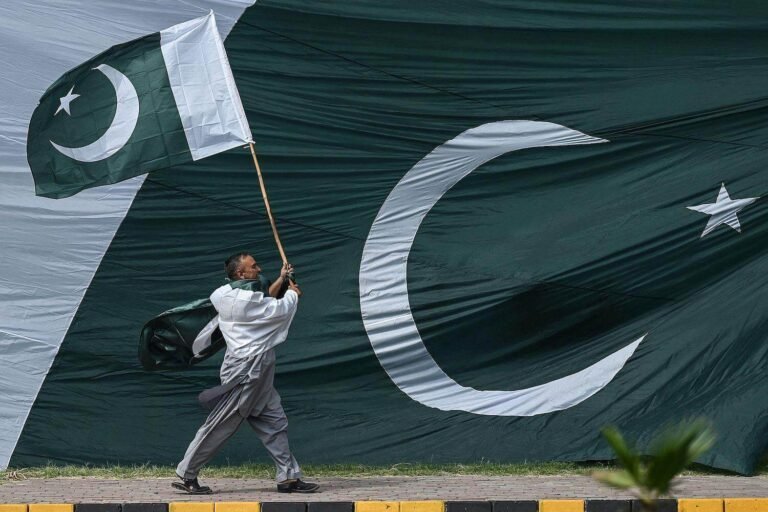
Prepare to be captivated, inspired, and transported through time as we embark on this unforgettable journey of discovery. So, in this article, we will take you on a journey to explore the Top 10 Best Historical Landmarks in Pakistan.
What is the Best Historical Landmark in Pakistan?
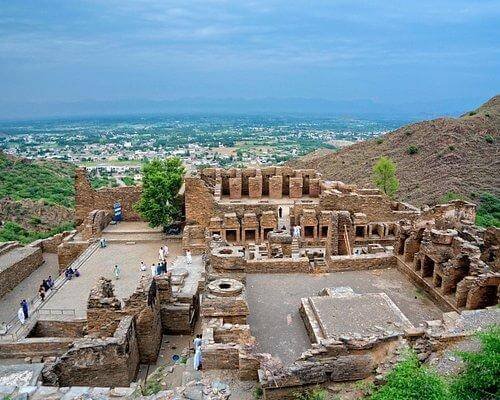
Determining the best historical landmark in Pakistan is challenging, as the country is adorned with many great sites that witness its rich cultural heritage. The best historical landmark is subjective and may vary based on personal interests, such as ancient ruins, sacred sites, or architectural marvels. Pakistan offers a kaleidoscope of options that cater to every historical enthusiast’s preferences. In addition to this, you may also like to see the Top 10 India’s Biggest Political Scandals of All Time.
The Best Place for you could be the one that sparks a deep connection, leaving an indelible mark on your memory. It could be a site that reflects the ingenuity and craftsmanship of its builders, the cultural significance it holds for the local communities, or the sheer beauty that takes one’s breath away.
After looking at all the other Historical landmarks on our list, let’s look at the Best Historical Landmark in Pakistan.
10
Badshahi Mosque (Lahore)

The Badshahi Mosque, a majestic and awe-inspiring sacred site for Muslims, graces the city of Lahore. Built-in 1673, it was the world’s largest mosque for over three centuries until the completion of the Faisal Mosque in 1986. A testament to Mughal architecture, the mosque boasts a sprawling courtyard spanning a vast area of 26,000 square meters, making it the largest globally and accommodating up to 95,000 worshippers.
According to New World Encyclopedia, reflecting traditional design principles, the mosque is adorned with four minarets and three domes, with the central dome being the largest, all boasting a brilliant white marble coating strikingly contrasting the dominant red hue. Step through the grand entrance gate, visitors are greeted by an interior that is no less breathtaking. Inside the Badshahi Mosque, the harmony of architectural mastery and artistic finesse truly transports visitors to a realm of wonder and spiritual serenity.
9
Lahore Fort (Lahore)
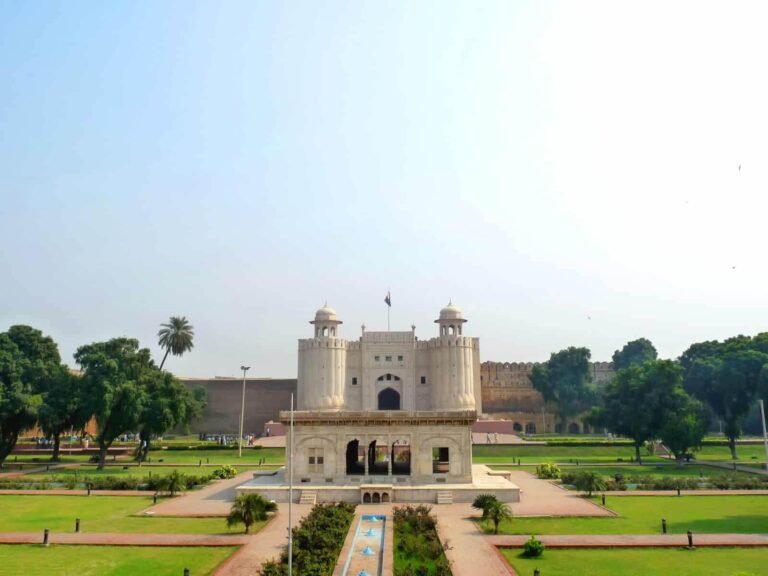
The Lahore Fort, an architectural gem nestled in the heart of the historic city of Lahore, stands as a testament to the grandeur of the Mughal era. It was built during the 16th century, and this magnificent fortress showcases a seamless blend of Islamic, Persian, and Hindu architectural styles. The fort’s sprawling complex encompasses various structures, including palaces, gardens, and pavilions, each telling a story of luxury and power.
As stated in Lonely Planet, Sheesh Mahal, or Palace of Mirrors, mesmerizes visitors with its intricate mirror work, reflecting light and creating a dazzling spectacle. Exploring the fort, you may encounter the majestic Alamgiri Gate, adorned with elaborate frescoes and calligraphy. The Diwan-e-Aam, or Hall of Public Audience, glimpses the Mughal court’s splendor, ornate pillars, and intricately carved marble. The Lahore Fort stands as a living testament to the region’s rich cultural heritage, inviting visitors to immerse themselves in the grandeur and history of the Mughal Empire.
8
Hiran Minar (Sheikhupura)

Hiran Minar, a unique and intriguing structure in Sheikhupura, Pakistan, is a testament to Emperor Jahangir’s love and admiration for his favorite pet deer. It was built in the early 17th Century, and this remarkable monument combines elements of Mughal and Persian architectural styles. Rising elegantly against the horizon, Hiran Minar is crowned with a pavilion adorned with intricate geometric patterns and exquisite tile work.
As mentioned by UNESCO, the minar is adorned with stone plaques inscribed with poetic verses and ornate carvings. Hiran Minar is a remarkable architectural marvel and a poignant symbol of the bond between humans and nature, making it a must-visit destination for history and nature enthusiasts. Surrounding the minar is a serene lake, adding to the tranquility of the setting. As visitors explore the site, they can meander through the lush gardens and experience the peaceful ambiance that pervades the area.
7
Derawar Fort (Cholistan Desert)
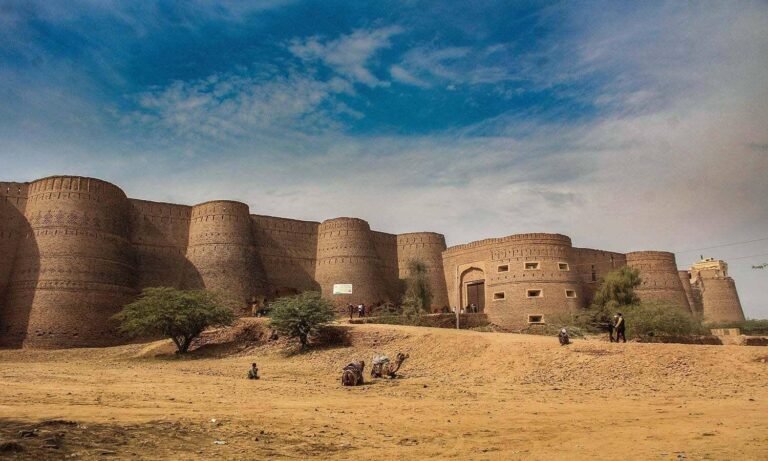
Derawar Fort, an architectural marvel rising from the sands of the Cholistan Desert, stands as a symbol of strength and heritage. The fort’s massive walls, crafted from baked bricks, stretch for miles, encompassing an area that seems to defy the vastness of the desert. It was built in the 9th century by Hindu Rajput rulers. The fort was later captured and rebuilt by the Nawabs of Bahawalpur in the 18th century. Its formidable structure, with forty towering bastions, evokes a sense of strength and resilience.
According to My Bahawalpur, you can explore the intricate maze of courtyards, royal chambers, and underground tunnels, each bearing witness to the fort’s storied past. The panoramic view of the fort offers a breathtaking vista of the surrounding desert, transporting visitors to a world of rugged beauty. Derawar Fort is a testament to the resilience of the Rajput and Nawab rulers, preserving their legacy and captivating the imagination of all who have the privilege of exploring its majestic walls.
6
Wazir Khan Mosque (Lahore)

The Wazir Khan Mosque, a splendid architectural masterpiece located in the heart of Lahore, Pakistan, is a testament to the artistic brilliance of the Mughal era. It was constructed in the 17th century by Emperor Shah Jahan’s governor, Hakim Ilmuddin Ansari. This mosque showcases a harmonious fusion of Persian, Central Asian, and local architectural elements. The intricate frescoes, vibrant tile work, and delicately carved marble enhance the mosque’s beauty and create a mesmerizing visual spectacle.
As stated in Asian Historical Architecture, The Wazir Khan Mosque is renowned for its exquisite calligraphy, with Quranic verses and intricate floral motifs adorning the walls and ceilings. As one enters the mosque, they are enveloped in a serene and spiritual atmosphere, with sunlight filtering through the lattice screens, casting ethereal patterns on the floor. As if you enter the mosque, they are enveloped in a serene and spiritual atmosphere, with sunlight filtering through the lattice screens, casting ethereal patterns on the floor.
5
Minar-e-Pakistan (Lahore)
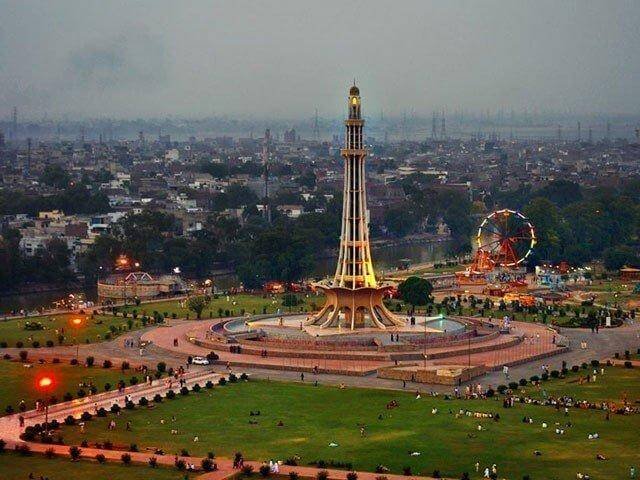
Minar-e-Pakistan, an iconic symbol of Pakistan’s independence, stands tall and proud in Lahore. This towering monument, built at the site where the historic Lahore Resolution was passed on March 23, 1940, marks a significant milestone in the country’s journey toward freedom. It was designed by renowned architect Nasreddin Murat-Khan. The Minar-e-Pakistan combines modern and Mughal architectural elements, creating a visually striking structure. Its base is adorned with intricate stone carvings that depict the region’s rich cultural heritage.
As mentioned in Visit Lahore, you are greeted by a breathtaking view of the surrounding cityscape if you walk the stairs. At the top of the Minar, a gallery offers panoramic views of Lahore, allowing visitors to appreciate the sprawling metropolis below. Minar-e-Pakistan stands as a symbol of unity, strength, and the indomitable spirit of the Pakistani people, reminding all who visit of the historical events that shaped the nation’s destiny. Its octagonal base, adorned with intricate patterns and calligraphy, pays homage to the region’s rich cultural heritage.
4
Tomb of Muhammad Ali Jinnah (Karachi)
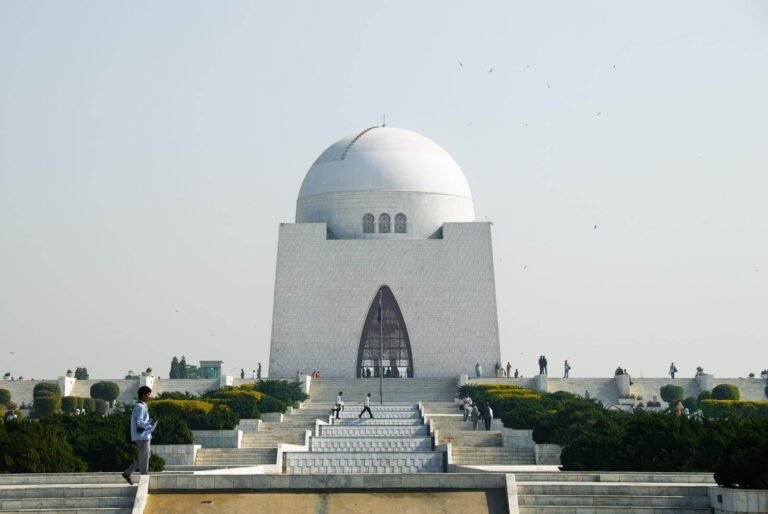
Mazar-e-Quaid, the final resting place of Pakistan’s founding father, Quaid-e-Azam Muhammad Ali Jinnah, is a place of profound significance and reverence, and it is located in Karachi. The magnificent mausoleum is a testament to the enduring legacy and vision of the man who led the country to independence and was designed by the renowned architect Yasir Merchant. Mausoleum’s pristine white marble structure stands in stark contrast against the city’s skyline.
According to Jagah Online, the mausoleum’s interior is adorned with intricate floral patterns, reflecting the beauty and diversity of the nation. You can pay respects to Quaid-e-Azam as you enter the dimly lit tomb chamber, where his grave lies. The serene atmosphere within the mausoleum inspires a sense of awe and respect, serving as a reminder of the sacrifices made to establish and uphold Pakistan’s sovereignty. Mazar-e-Quaid is a memorial to Quaid-e-Azam and a national unity and pride symbol.
3
Pakistan Monument (Islamabad)

The Pakistan Monument, a striking architectural masterpiece in the heart of Islamabad, captured the essence of Pakistan’s rich heritage and cultural diversity and was designed by Arif Masood. The main structure consists of a large blooming flower petal-shaped platform, with the star and crescent of the national flag at its center. And covering the platform is a series of interconnected petal-shaped structures, each representing one of the four provinces of Pakistan. The intricately carved walls depict scenes from the country’s history, celebrating its vibrant traditions and remarkable achievements.
As mentioned in Lok Virsa, the Pakistan Monument, is nestled in the picturesque Shakarparian Hills of Islamabad. Surrounded by lush green gardens and serene reflecting pools, the Pakistan Monument provides a peaceful and contemplative space for visitors to connect with their shared history and values. The Pakistan Monument serves as a reminder of the nation’s resilience and aspirations and a beacon of hope and inspiration for all who visit.
2
Faisal Mosque (Islamabad)
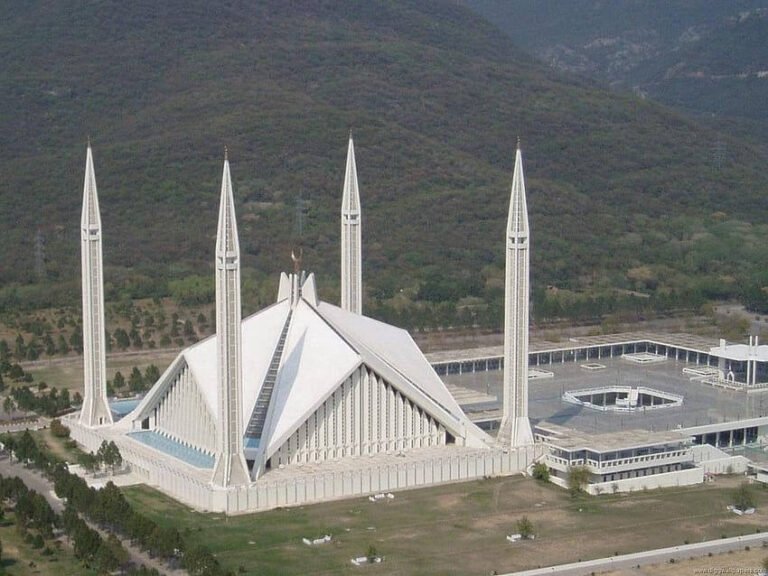
The Faisal Mosque, a magnificent architectural masterpiece in Islamabad, stood as a testament to Pakistan’s strong Islamic heritage and modernity and was designed by Turkish architect Vedat Dalokay. It is named after King Faisal bin Abdulaziz Al Saud of Saudi Arabia, who played a vital role in its funding and construction. Its soaring minarets and the majestic main prayer hall can accommodate over 100,000 worshippers, making it one of the largest mosques.
As stated in Mosqpedia, the exterior of the mosque is adorned with clean lines and sleek marble. At the same time, the interior boasts intricate calligraphy and intricate geometric patterns that reflect the depth of Islamic artistry. The serene ambiance and breathtaking beauty of the Faisal Mosque make it a spiritual haven for worshippers and a symbol of religious harmony and architectural excellence. The Faisal Mosque is a place of worship and a symbol of national pride and religious tolerance, welcoming people from all walks of life.
1
Shalimar Gardens (Lahore)

Shalimar Gardens, located in Lahore, Pakistan, is a breathtaking testament to the Mughal era’s architectural and horticultural excellence. In the 17th century, it was created by Emperor Shah Jahan. The gardens were designed to be a paradise on Earth, offering respite and beauty to those who wandered through its lush greenery. The gardens feature intricate terraces, fountains, water channels, and pavilions, all meticulously designed to create a harmonious and serene atmosphere.
According to Locally Lahore, the symmetrical layout of the garden, combined with the careful placement of flora and fauna, creates a visual spectacle that captivates visitors. Shalimar Gardens, a UNESCO World Heritage Site, is an iconic destination showcasing Mughal architecture’s grandeur and landscaping. The gardens span over 80 acres and feature three terraces, each with a distinct charm. It is a must-visit destination for anyone seeking to immerse themselves in the grandeur and grace of Pakistan’s rich historical heritage. That’s why Shalimar Gardens is the Best Historical Landmark in Pakistan.
What are the Best Historical Landmarks in Pakistan?
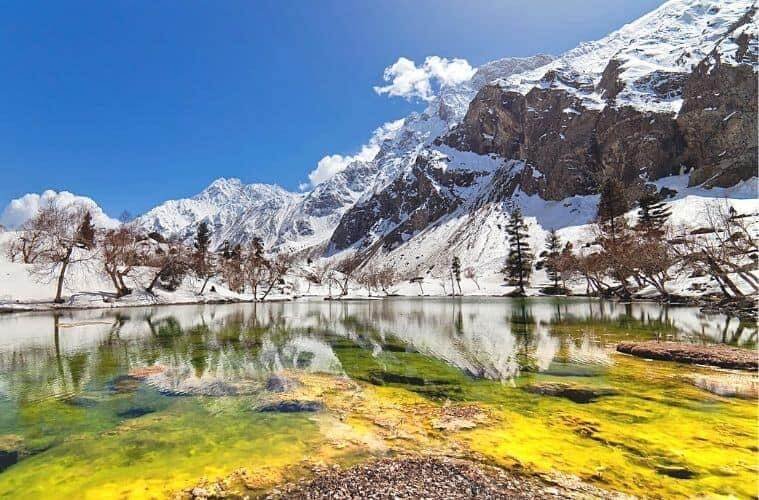
Pakistan has a vibrant history, boasting numerous historical landmarks that testify to its cultural heritage. These landmarks serve as tangible connections to the past, allowing visitors to immerse themselves in the stories and legacies of those who came before.
Each of these historical landmarks has its charm, significance, and unique story. From ancient archaeological sites to great architectural wonders, each historical landmark holds its unique significance and contributes to Pakistan’s collective identity.
Here is the list of the Top 10 Best Historical Landmarks in Pakistan:
- Shalimar Gardens (Lahore)
- Faisal Mosque (Islamabad)
- Pakistan Monument (Islamabad)
- Tomb of Muhammad Ali Jinnah (Karachi)
- Minar-e-Pakistan (Lahore)
- Wazir Khan Mosque (Lahore)
- Derawar Fort (Cholistan Desert)
- Hiran Minar (Sheikhupura)
- Lahore Fort (Lahore)
- Badshahi Mosque (Lahore)
Exploring these landmarks provides an opportunity to appreciate the country’s diverse heritage, witness the architectural prowess of past civilizations, and gain a deeper understanding of Pakistan’s historical narrative. Moreover, you can check out the Top 10 Most Shocking Political Assassinations of All Time and the Top 10 List of Most Spoken Languages in Asia (Updated). Moreover, you can also read the Top 10 Reasons Why We Should Celebrate National Chocolate Cake Day for your additional knowledge.
PIN IT!
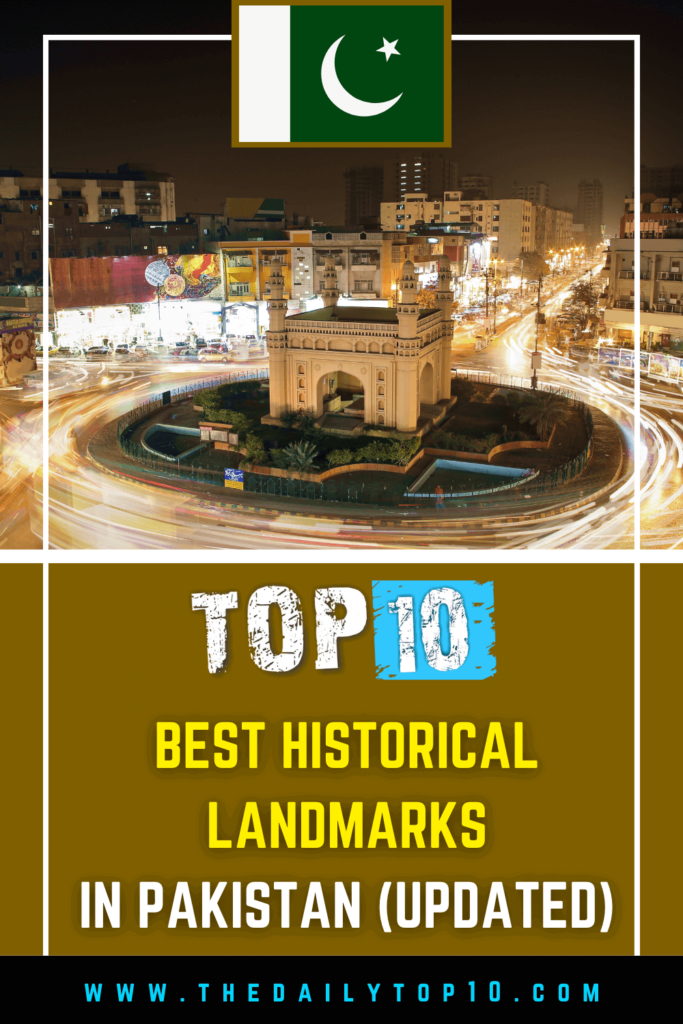

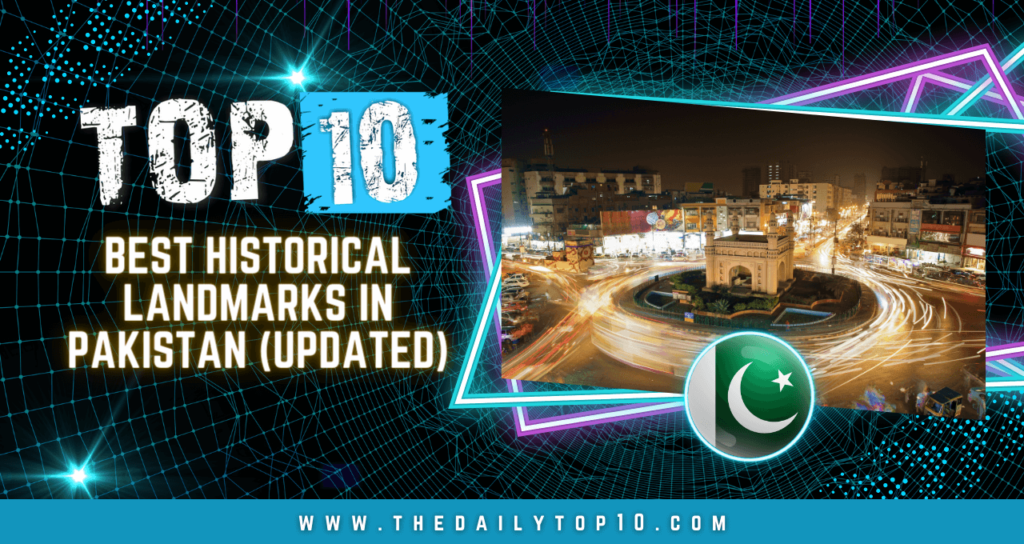



Top 10 Best Undergraduate Business Programs in the USA (Updated)
Top 10 Most Expensive Restaurants in Canada (Updated)
Top 10 Most Romantic Places for Couples to Visit in Thailand
Top 10 Things Foreigners Should Never Do in Australia (Updated)
Top 10 Best & Most Popular Baby Girl Names in New Zealand (Updated)
Top 10 Best Health Insurance Companies in Germany (Updated)